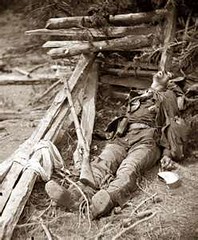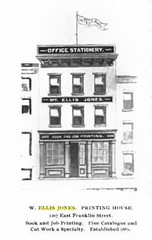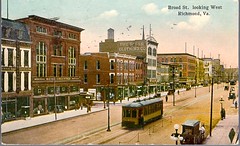AUTHORS NOTE: Since drafting the entry below, new facts have come to light which COMPLETELY DEBUNK several ideas put forth here in. Rather than “erase” or delete my mistakes, as if they never happened (which occurs all too frequently on the net), I have chosen to “redact” them by crossing through the patently false, or overly speculative portions of the text. For more information, please refer to my post “Epic FAIL | Confessions of a highly speculative genealogist“.
 William Jones of Bryntirion (
William Jones of Bryntirion (c. 1734 – 1830) (Baptized April 3, 1757 – d. February 2, 1830. Source: Dr. Lewis William Lloyd, “A Merioneth Family of Printers in Wales and the U.S. A.“, from the Merioneth Historical and Records Society Journal, Vol XII (iv), 1997.)
We can now turn our full attention to Richard and Ann’s younger son William Jones. William was born about 1733 or 1734; at Tyddyn Du.
From The Baby Book we have the following facts:
– William became a printer at Dolgellau in the neighborhood near Tyddyn Du and Bryntirion.
– He also became a devoted Wesleyan and wrote for their publications.
– He wrote under the pseudonym “Nebo”.
– His sons; Lewis Evan and Richard, also became printers.[7]
These are thin facts that have been passed down in the family lore about William. Let’s consider them with the same attention with which we examined his brother, David’s life.
William was the younger of two sons, and following custom it would have been understood that he would not inherit his father’s property (at least not the greater portion of it.) Given this understanding, it would have been expected that William would take up a profession. In the case of a family that was trying to raise its social standing (as we know Richard Jones certainly was), this usually meant that the young man in question would be prepared for a career either in the law or the clergy. The fact that William took up printing (a trade, not a profession) is a bit curious.
Regardless of William’s career choices, he met with success. We can surmise this on a couple of accounts.
First; unlike his brother David, William was able to marry at a somewhat earlier age, although not much earlier. His first son, John Jones, was born in 1781, which means that William was fifty-three years of age or older when his first child was born.
Second; we can conjecture that William was able to set his sons up with successful business establishments. Both Lewis Evan and Richard Jones were operating busy printing and publishing operations by the time they were of age. Richard especially, became a great success with multiple publishing firms operating throughout Wales during his lifetime. None of this would have been possible without a substantial amount of start-up capital. That William had the cash available to set his sons up in their own businesses is evidence of his success as an entrepreneur and a manager – to say nothing of his connections to authors and writers, whose output was essential to his work and cash flow.
Beyond the scant information about William found in The Baby Book, we’re blessed with another source which recalls facts of this fascinating man’s life.
From The Origin and History of Methodism in Wales and the Borders published in 1893, we have the following:
“In November 1804 Mr. Griffith Hughes preached at Llechfrith, under an oak, several men who afterwards became prominent Wesleyans being present. Amongst them were Owen Jones, who entered the ministry in 1808; William Jones, Bryntirion, and his son Richard. When Mr. Jones (Bathafarn) went to preach at Llechfrith, amongst others who heard him preach and was pleased with the service was William Jones of Bryntirion. He invited the preacher to his house, delighted with his preaching and deeply impressed by his beautiful Christ-like spirit. William Jones was the heir of Tyddyn-du-Llanabar, and had been partially trained for the ministry in the Church of England. He was a good linguist, had mastered Greek, Latin, and Hebrew, but declined to go on to the University, because, as he said, he did not feel called to preach the gospel, and with that conviction could not tell a lie and take Holy Orders. So instead he became a joiner. He had been a member of the Calvinistic Methodist Society for twenty-six years, but for some time many members of that body had been very dissatisfied with him because he appeared too sympathetic with the Congregationalists and other bodies; and when they heard (what) he has done to hear the Wesleyan preacher and taken him to his own house, they were terribly annoyed. Some said that he was a heretic. All agreed that his case must be considered. Mr. Jones was admonished, but without effect. The Association meetings were held at Dolgelley in November 1808, and his case was brought before the assembly. There was a strong feeling in favour of expelling him. An old minister, however, earnestly contended that Mr. Jones should be allowed to remain on the deck as the only hope of his salvation, at the same time trusting that he would see the error of his way. The advice of the old minister ruled the day. Next day the celebrated John Elias preached a very powerful discourse on the importance of orthodox views. Mr. Bryan visited the neighborhood, and William Jones left the deck and joined another crew on board another ship. The following Sunday a Mr. R. Griffith preached a sermon on Isaiah ii. 22, ‘Cease ye from man, whose breath is in his nostrils; for wherein is he to be accounted of?’ The sermon was chiefly for William Jones; if not to be accounted of, he was worth a discourse from the preacher who wished to ignore him. William Jones became an active and zealous worker in the new church. In 1810 he erected a Wesleyan chapel on his own land, and it was called Nebo. His wife and his family identified themselves with the Wesleyans, and two of his daughters married Wesleyan ministers – Rev. Thomas Thomas and Owen Jones. His son Richard became the printer of the Eurgrawn and other books, and an able local preacher; one daughter, the wife of Morris Morris, Halfway House, Bontddu; …and another, the wife of W. J. Roberts, Havod-y-Coed. William Jones died in the peace of the gospel, surrounded by his family and friends, February 2, 1830.”(8)
Despite the somewhat arcane language and awkward metaphors, this colorful portrait of William Ellis Jones provides us a great deal of material to work with as we attempt to flesh out a more complete picture of our subject.
Let’s first have a look at the personal details of William’s life and personality. The text states: “William Jones was the heir of Tyddyn-du-Llanabar (the Black House of Llanabar)…”, which makes it clear to us that his father, Richard, did in fact leave William with at least one property near the family seat at Tyddyn Du, (but a completely different parcel than any of the three previously noted in The Baby Book) [9]
This fact supports my earlier supposition that Richard Jones was a man determined to increase his family’s status and prosperity. Richard continued to acquire new land and properties with the intention of setting his sons up in security. The fact that William owned a farm as well as a printing business shows us that his income was derived from more than one source. He had a backstop against failure in one pursuit; he could rely on income from the other to get him through difficult times.
This sketch gives us a picture of a devout man, aged at the time about seventy years. At the time of his conversion to the Methodist cause (which was still aligned at that date with the Church of England), William had already been an active member of the Calvanistic-Methodist congregation (a strictly non-conformist sect) for twenty-six years. This substantial reversal in spiritual practice coming nearly forty years after having been intended for the Anglican ministry as a young man. The profession his father Richard had so carefully planned and financed for him, William thwarted, stating; “…he did not feel called to preach the gospel, and with that conviction could not tell a lie and take Holy Orders.” And now at seventy, he reversed his affiliation again and joined the Wesleyans! What a fascinating individual! A man who never stopped asking deep, spiritual questions and who never closed his mind to evolutionary ways of thinking about important but controversial issues.
What’s even more inspiring though is William’s confidence and bravery in the face of his neighbor’s condemnation. According to our source, some of his neighbors called him a heretic. If that’s true, that’s a hard judgment to lie at the door of a neighbor and friend, especially when we consider what a tiny community William lived and moved in. It’s likely that in William’s lifetime the population of the community around Tyddyn Du doubled or even tripled, the actual number of households in the neighborhood still could not have been more than two or three hundred at most. To lay the accusation of heresy at the door of a neighbor was a serious matter, and the church took it seriously. Thus we read;
“…All agreed that his case must be considered. Mr. Jones was admonished, but without effect. The Association meetings were held at Dolgelley in November 1808, and his case was brought before the assembly. There was a strong feeling in favour of expelling him….”
Excommunication; a big word and a big threat. This threat was tantamount to a community-wide shunning; the ultimate isolation. All this for having the intellect and courage to think for himself. Most men’s reaction would be to fold, recant, sit down and shut up. Not William. He didn’t wait to be kicked out of their club. He put a thumb in their eye, joined the Wesleyans, and then, “…he erected a Wesleyan chapel on his own land, and it was called Nebo.”[10] His stubborn determination is all the more profound when we consider the fact that he and his son Richard had a business in town and at least a portion of their livelihood was dependent upon community connections. His decision was brave indeed; a testimony to his willingness to put his faith in God first, his faith in himself a close second, and faith in his neighbors and their narrow opinions, far behind. This is a man with strong convictions and flexibility of thought.
His convictions and his bravery obviously inspired the entire family. It appears that from this point forward, many if not most of the Joneses (both William and David’s family’s), converted to the Methodist faith and aligned themselves with the Wesleyan’s who only officially left the Church of England in 1811.
(See the select bibliography of William Jones of Byntirion.)
———————-
[7] The Baby Book | William Ellis Jones Jr. Family History, By William Ellis Jones (1930) Note 10, par. 3 and 4.
[8] The Origin and History of Methodism in Wales and the Borders by David Young (1893) Edinburgh | Morrison & Gibb, Printers. Pages 589 – 590
[9] “…The most remote ancestors of whom I have been able to secure accurate information are Richard Jones and his wife Ann…Richard Jones was a farmer and lived on his own farm at Tyddyndu (Tyddyn Du), between Dolgelly (Dolgellau) and Barmouth. He was a man of some substance, for in addition to this property he also owned farms at Potddu (Bontddu) and Thy’nyburth…”
The Baby Book | William Ellis Jones Jr. Family History, By William Ellis Jones (1930) Note 10, paragraph 2.
[10] Nebo is a mountain in Jordan, northeast of the Dead Sea. It is the highest point of a ridge known as Pisgah, from which Moses viewed the Promised Land just before his death. (Deuteronomy 34:1).










February 12th, 2015 at 3:10 pm
Thank you for all your research and time you have taken to read this. William is my great x6 (I believe) Grandad and it is fascinating to read such detail to his life. I visited Bont Ddu myself and loved roaming around the land and seeing buildings from the past involved in the family, I found the old Chapel (a converted house now) in the garden still stands a stone memorizing William. I also visited the churchyard and saw Richard and Catherines graves. I love the feeling of knowing so far back on our family history. I’m the last Jones on my line now but still young with plenty of time to continue the legacy. Thank you for keeping it alive. Iain Jones, Dorking, Surrey, UK
February 12th, 2015 at 8:18 pm
Hello Iain,
Thank you so much for this note. I would VERY MUCH like to follow-up with you. We’re distant cousins and I’m an avid geneologist. I’d love to add your line to my research. I’d also love to hear about your travels at Bont Ddu. I’ve never been there and never even seen any good photos. I had no idea Richard and Catherine’s graves were still known! That is wonderful news! You’ve made my day with your note. 🙂
May I email you?
–Connie Jones
February 12th, 2015 at 3:11 pm
Reblogged this on iainjones56's Blog.